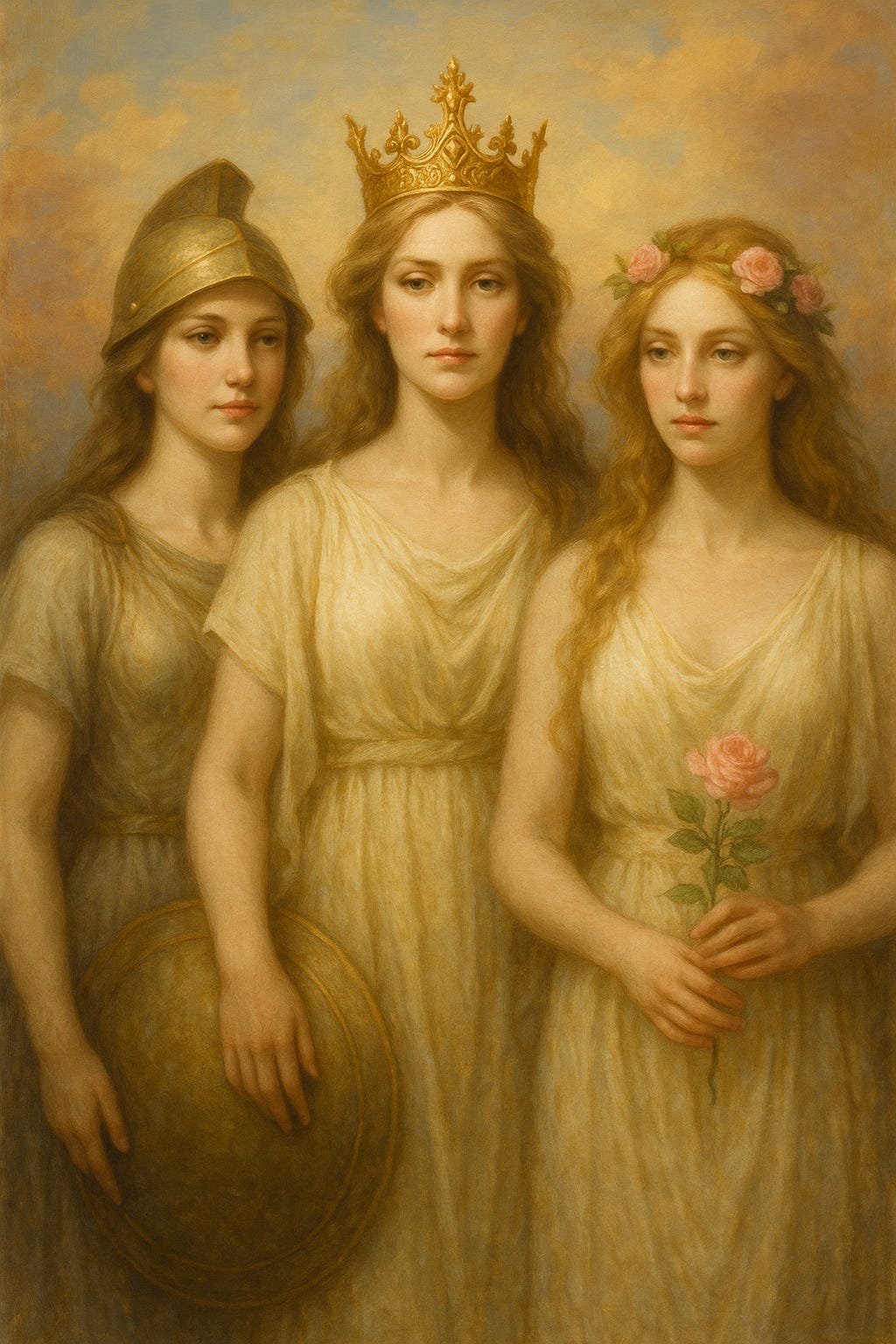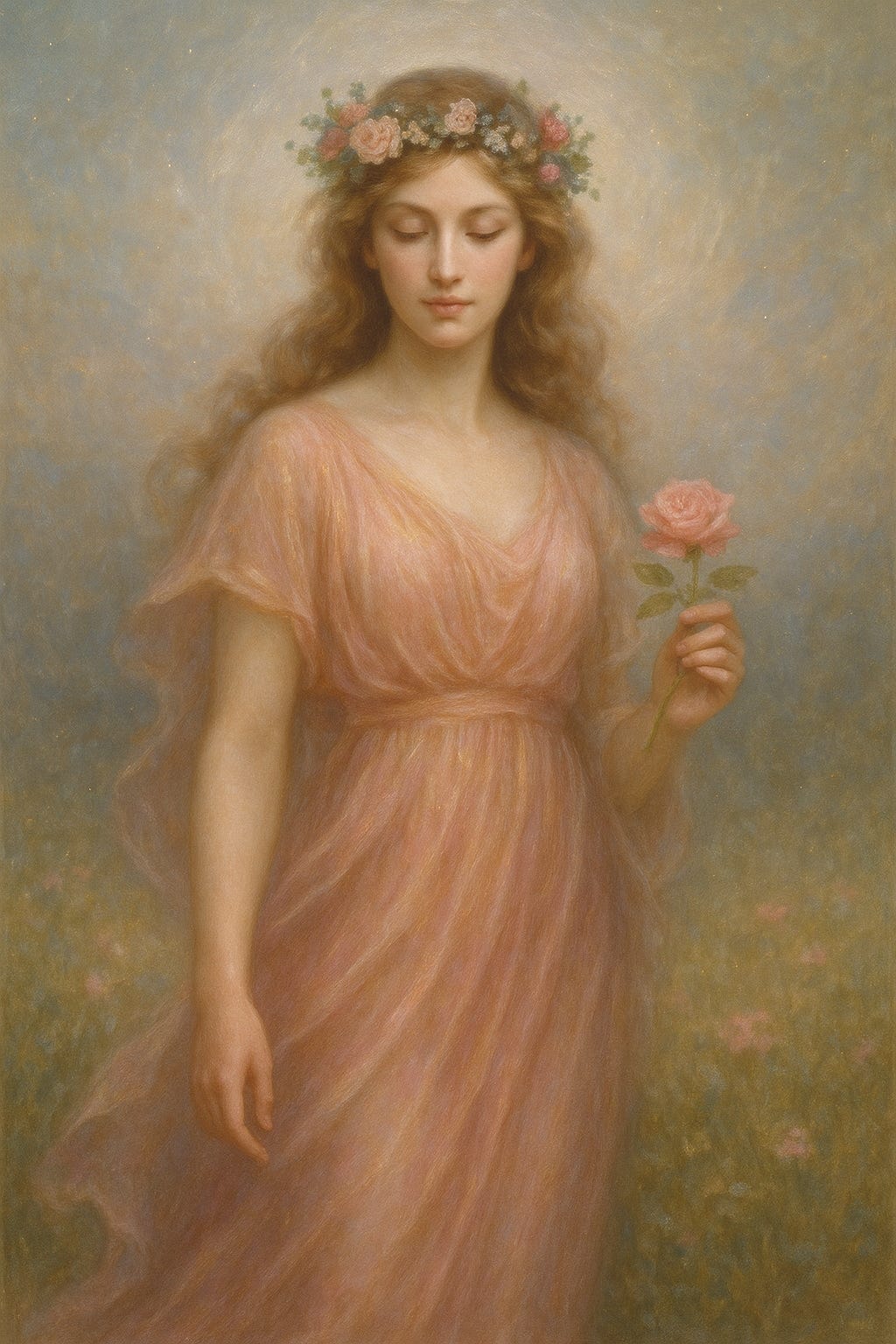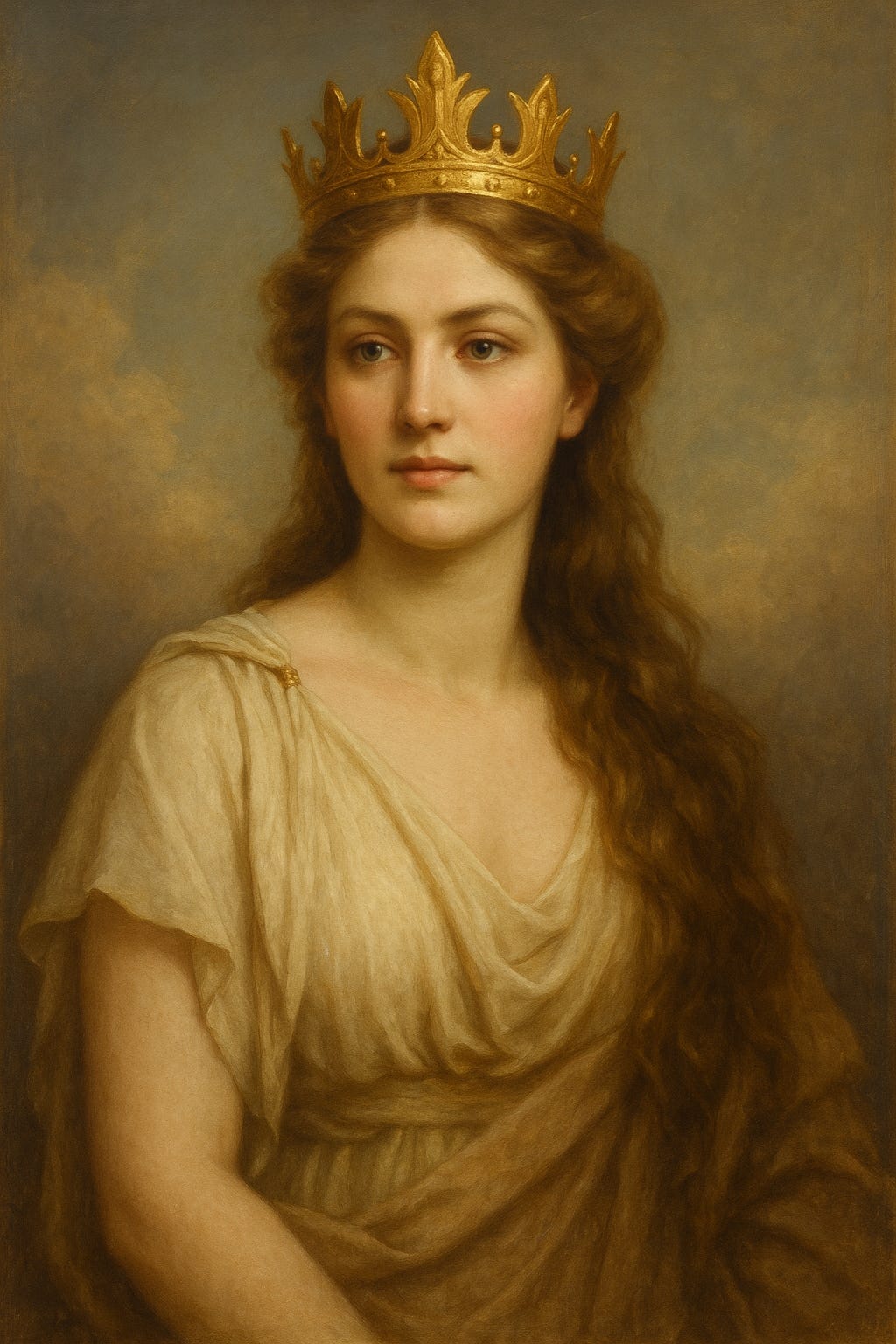The Chronicles of the Sky-Veil: Chapter V
The Day of Naming
The Chronicles of the Sky-Veil is a mythopoetic journey through the silence between worlds.
In The Chronicles of the Sky-Veil, the nameless man on the Journey Across the Sky-Veil writes his journal in the empty book given to him mysteriously in a satchel while sleeping. He reveals his thoughts as the Journey unfolds. In The Chronicles, the reader discovers the man’s hidden thoughts and the remembrances transforming him from a wanderer to an heir of the Majestic Highlands.
This is not sentimentality or mere imagination. It is not theology or philosophy. It is the story of the nameless man’s remembrance-in-the-world—told in myth, rooted in mystery. His is a journey from the Grey-Beneath to the Highlands of Majesty, through rose and flame, shield and crown.
From the Nameless Man’s Chronicles of the Sky-Veil1
There were days when the veil parted not with subtlety but with lightning. One such day, the horizon did not merely shimmer with the weight of Being—it flashed. That day, once hidden behind the hush of rosy dawn, then stood unveiled, not as symbol alone but as a naming. It was the day I was claimed.
The air of the Sky-Veil had long been stirring with connected meanings—patterns of beauty, flashes of wisdom, the soft light of order. These were not abstractions. They danced. They led. But they had not yet declared themselves. I walked, as one walks in contemplation, through fields of meaning whose source remained veiled, even as their nearness2 moved me. But on that day, what had shimmered now stepped forward.
The Rose-Bearer3 came first—not in new attire, but as one recognized at last. Aphrodite, whose path I had unknowingly followed, appeared radiant at the threshold. She had drawn me from the Grey-Beneath4 with soft insistence, bearing no creed, no law—only the gleam of what must be followed. Her touch had not taught me love. It had taught me to desire love—to be vulnerable to it, to ache with it, to beg its beauty to save me.
And save me, it did—but not alone.
There was one who had stood beside me in the valley of affliction, when even the gods seemed too far. It was the Aegis-Bearer,5 though then I did not know her name. Athena had been with me in the fight, heralding the flame of a saint beyond. It was she who had whispered in the silence, who had guided my intellect even when my strength was broken. Her wisdom did not instruct—it compelled in alethic wonder. In the moment of my restoration, when chains of affliction shattered like old iron against stone, it was she who lifted the blade. She who named me son.

And from the heights, veiled in majesty, the third came forth. Hera, the Queen of the Sky-Veil, stepped into view. She did not move toward me—she had always been nearby. Every structure I had built toward meaning, every longing for home, every ache for belonging had been her nearness—calling, not as doctrine, but as presence. She was not content to reveal herself as beauty or wisdom. She was recognition of Majesty. Her realm was the Highlands, the Kingdom Aphrodite had first revealed to me in the distance.
The revelation was not linear. It was a circling flame. The saints on the far side, for whom I had searched with affection, now stood not behind the veil, but as the event of belonging—still themselves, yet radiant with more. Their features refracted across the landscape through the heralds of the Veil. They had always been my safe harbor sought, but then they spoke through the nearness of heralds capable of entering my heart, wearing names older than history: Rose-Bearer. Aegis-Bearer. Sky-Crowned.
And so, that day the heralds named me—not audibly, but with the nearness of the saints piercing the mist with their light. Not with theology, but with the sacred rhythm of beauty, wisdom, and majesty. On that day, I became a wanderer no more. I became a son of the Sky-Veil.
Let it be known—those who walk with Aphrodite shall be broken open until beauty becomes nearness. Those who are guided by Athena shall be wounded until wisdom becomes a living fire. Those who are ordered by Hera shall be emptied until majesty becomes crown.
This was not about me. I was nothing. I was only a reflection—cast by three who reflected not themselves, but the light beyond the Veil where the saints dwelled. To speak of me was to speak of them, and to speak of them was to kneel before the light beyond even the Highlands.
So let the story turn. Let the reader now see what once had only been foreshadowed. For the Veil lifted, and what was once myth became disclosed as sacred.
Enjoy “The Crowning of Aphrodite” from my album Mythic Canticles, available on my music site.
Lyrics ©Walter Emerson Adams. Music and vocals by Suno ©Walter Emerson Adams.
When Aphrodite found the words, she stilled She knew at last the happiness, rejoice! Capricious nature, lover of the thrilled Instead, she bore a name and found her voice Now sing for joy, O Lover, songs renewed! These words, devour, in which you find delights Now offer, Aphrodite, goddess rued Divinity for crowns beyond your heights Conflicted, troubled, Aphrodite rest! The words you found at night have set you free No more your anxious scheming must you test O Lover, hold the shimmer ere it flees Your jealousy for beauty others see Must never hold a Princess, your renown These words renew and grant nobility For Aphrodite, majesty her crown
✦ Sky-Veil - The threshold of Being in this mythopoetic cosmology, representing the veil between the mundane, flat world of day-to-day existence and the enchanting retrieval of Being—between symbol and meaning, longing and fulfillment. The Sky-Veil refers to this as moving from “forgetfulness” (flat world) to “remembrance” (enchantment gleaming around the divine we have always known but forgotten). It is across the Sky-Veil that hypostatic heralds of Being—embodied symbolically by the goddesses—shimmer, and through which the soul journeys in mythic wonder toward divine encounter. Saints dwell beyond the veil in the Highlands of Majesty and the contemplative Grove Beyond; the goddesses, as “hypostatic emergences” foreshadowing divine virtues, herald through the liminal “space” in the world we encounter.
✦ Nearness - Not spatial proximity but a mode of disclosure—the drawing-near of Being itself in moments of unveiled significance. It conveys a presence that is not fully present, a proximity that is not measurable, but rather experienced in the heart’s intuition and the soul’s readiness.
In Heideggerian terms, nearness belongs to the mystery of Being’s self-showing (aletheia). It is the threshold where the veil stirs but does not part, where the divine does not arrive as an object but becomes luminously felt. Nearness is not what we possess but what approaches us, like the breeze that carries meaning without language. It is the quiet shimmer before revelation—the silent resonance that moves before the Word.
In the Sky-Veil, nearness is the air the wanderer breathes when the heralds pass by, the fragrance of the rose before it is seen, the warmth of the flame before it is touched. It is the grace of Being brushing against the soul, unseizing, ungraspable, yet unmistakably there.
✦ Rose-Bearer - A luminous guide, often aligned with Aphrodite in the cosmology of the Sky-Veil, who initiates the wanderer’s first awakening upon the path of the gleaming golden thread. Joyful, radiant, and full of grace, she dances ahead of the procession, scattering unseen petals of invitation toward the Veil. Her rose is not merely a flower, but a sign—fragrance of the divine, image of love’s first light, and a herald of Beauty that beckons from beyond.
She is the one who calls the wanderer to cross the threshold between forgetfulness and remembrance—from the flat, mundane to the enchantment of the divine. With mirth and clarity, she does not command but delights, drawing the soul not by force, but by the joy of her presence. In the cosmology of the Sky-Veil, Aphrodite is not a goddess but a harbinger of divine love—she who glimmers and sparkles, unfolding the divine grace from its hiding, making the soul beautiful in the image of Beauty Himself.
To follow the Rose-Bearer is to consent to the first echo of grace—to risk wonder, to pause in the hush before reason, and to “remember” the path home.
✦ Grey-Beneath - A dim and weightless world from which the wanderer first emerges. It is a place of sorrowful vagueness—a shadowed domain where remembrance fades, names are lost, and Being lies concealed beneath layers of distraction and half-light. One does not live in the Grey-Beneath so much as drift.
In the cosmology of the Sky-Veil, the Grey-Beneath represents the pre-awakened state, the soul’s distance from beauty, wisdom, and majesty. It is the quiet exile from one’s true calling, the place where the golden thread is first glimpsed but not yet followed.
To leave the Grey-Beneath is not merely to ascend—it is to remember.
✦ Shield-Warrior with the Aegis - The luminous figure of wise defense and discerning might who appears as a guardian of the threshold. Bearing the radiant aegis and a polished shield, she is not merely a protector, but a revealer—one who sees clearly through illusion and stands at the liminal edge where discernment must precede ascent.
She is the figure aligned with Athena, not in her classical militancy, but as a hypostatic herald of wisdom in service of love. Where the Rose-Bearer awakens longing and joy, the Shield-Warrior tempers that desire with clarity, protecting the path from disordered longings. She does not wage war in the worldly sense but guards the journey of the soul from false light and hidden snares.
Her aegis, emblazoned with the sign of divine presence, is both a warning and a shield—a symbol that dazzles and defends. She teaches the soul that the draw of beauty must be fortified by virtue, and that enchantment without wisdom and courage will falter through the Veil. Her appearance marks a pivotal moment in the journey: the awakening of holy vigilance and the call to heroic remembrance.
To receive the Shield-Warrior’s gaze is to be known in one’s Being. To follow her is to walk the narrow path of noble ascent, where wisdom is aflame with love, and courage is guided by luminous discernment.





